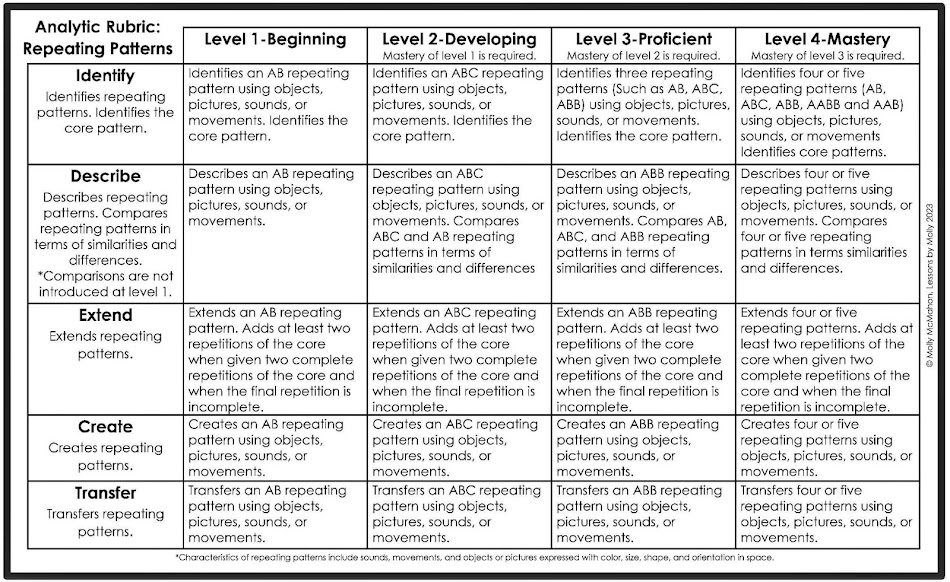In my previous post, I explored the various ways to express repeating patterns and discussed those that require thoughtful consideration. In an earlier post, I also explained the five essential components and their alignment with Bloom's Revised Taxonomy (2001): Remember, Understand, Apply, Analyze, Evaluate, and Create. Let's revisit the kindergarten objective from the Virginia Department of Education Standards of Learning (2016): K.13 - The student will identify, describe, extend, and transfer repeating patterns. While the aim emphasizes the importance of repeating patterns, it does not specify which patterns to teach. Fortunately, the VDOE Standards of Learning Curriculum Framework (2016) provides us this five patterns to explore. I have listed them and highlighted the core.
1. ABABABAB
2. ABCABCABCABC
3. ABBABBABBABB
4. AABBAABBAABBAABB
5. AABAABAABAAB
Among these, the most straightforward repeating pattern is the AB, making it an ideal starting point for instruction. Before progressing to more complex patterns, students must master all five components (identify, describe, extend, create, and transfer) of the objective. A solid understanding of these domains within the AB pattern sets the foundation for comprehending more intricate patterns. Once students have mastered the AB pattern, the next step is to select one of the remaining four repeating patterns. The ABC pattern is particularly suitable, as kindergartners can effectively mimic it through movement or sound.
When considering the five types of repeating patterns and the five components, 25 performance tasks emerge! Furthermore, this objective requires using different media types, including objects, pictures, sounds, and movements. However, there's more to this objective than meets the eye. The VDOE Standards of Learning Curriculum Framework (2016) describes identifying the core pattern. The core pattern represents the beginning and end of the pattern without any repetitions. For example, in the pattern ABBABBABB, the core pattern is highlighted. Upon careful examination of the details outlined in the VDOE Standards of Learning Curriculum Framework (2016), it becomes evident that identifying the core pattern aligns with the "identify and describe" component. However, it is essential to note that "identify" and "describe" should not be used interchangeably. We can employ "identify" to name the core pattern and reserve "describe" for elaborating on its repetitions and the media used, such as objects, pictures, sounds, and movements.
Although not explicitly mentioned within the five components of the objective, the VDOE Standards of Learning Curriculum Framework (2016) also mentions comparing similarities and differences among repeating patterns. This aspect introduces a sixth component to the standard, despite not being explicitly stated in the objective. Furthermore, when given a complete repetition of the core, students are required to replicate the pattern a minimum of two times. Additionally, students must replicate the pattern at least two times when provided with an incomplete repetition of the core.
Regarding the five types of repeating patterns, it is worth noting that first grade does not reintroduce them. The repeating patterns specified in the VDOE Standards of Learning Curriculum Framework for first grade are more complex.
Feel free to utilize the analytic rubric provided below for repeating patterns. However, kindly note the the VDOE does not endorse it. Just tap the image to access it or use the QR code show below.
While the objective of K.13 - identifying, describing, extending, and transferring repeating patterns - provides a clear focus, it is crucial to consult the VDOE Standards of Learning Curriculum Framework (2016) for a complete picture of what children need to know. The framework expands upon the objective, offering specific examples of patterns and highlighting additional aspects like identifying the core pattern and comparing similarities and differences. Relying solely on the objective may limit our perception of the required depth and breadth of knowledge and skills. Embracing the curriculum framework as a companion empowers us to design comprehensive and practical lessons that support students in mastering the complexities of repeating patterns
While exploring educational resources that claim to be fully aligned, we often encounter some that raise our eyebrows. These resources boast alignment with the repeating patterns standards, yet upon closer examination, they may fall short of delivering on their promises. A future blog post will delve into this matter, presenting evidence that sheds light on the accurate alignment of these resources. Stay tuned as we uncover the truth and separate the truly aligned from the mere claims.
If you missed the previous two posts on repeating patterns, view them here:
Kindergarten Repeating Patterns Objective: Unveiling the Five Components
© 2023 Molly McMahon, Lessons by Molly
(References: 1. Virginia Department of Education, Standards of Learning, 2016. 2. A Taxonomy for Learning, Teaching and Assessing; A Revision of Bloom's Taxonomy of Educational Objectives, Lorin Anderson, David Krathwohl, Peter Airasian, Kathleen Cruikshan, Richard Mayer, Paul Pintrich, James Raths, Merlin Wittrock.)





No comments:
Post a Comment